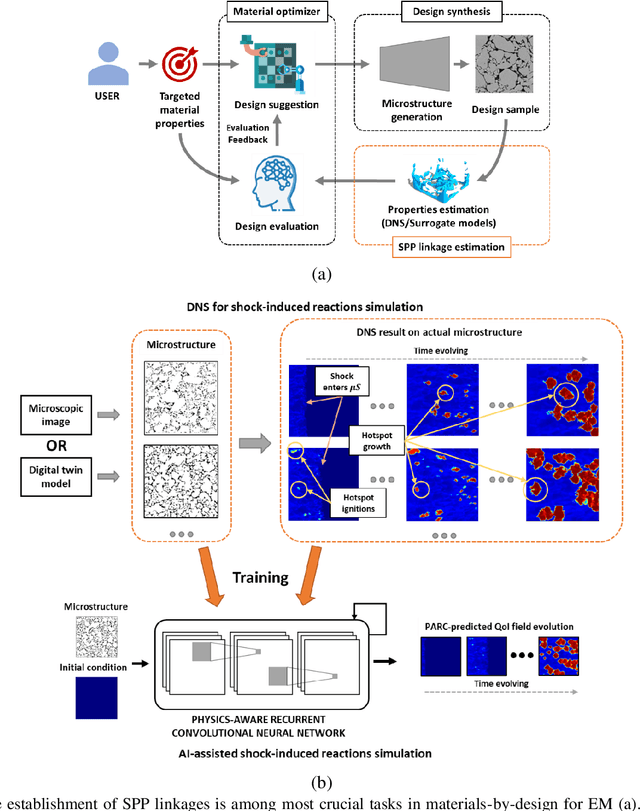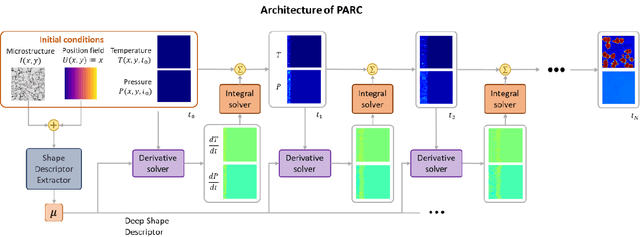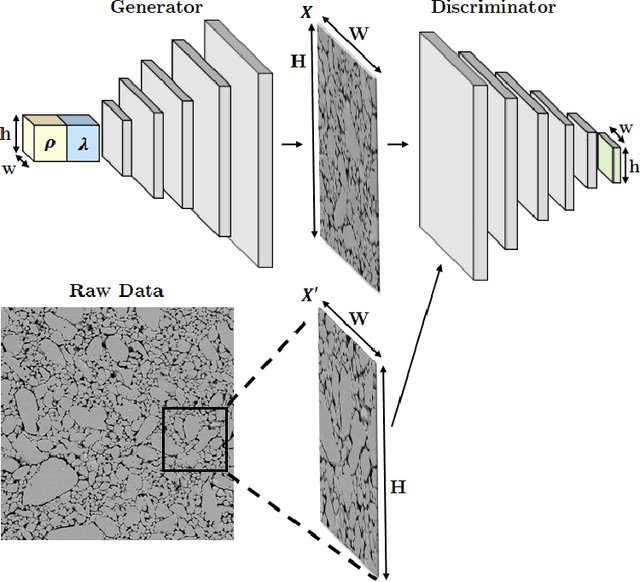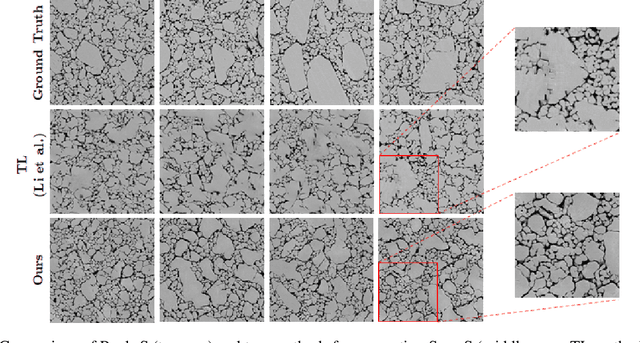H. S. Udaykumar
PARCv2: Physics-aware Recurrent Convolutional Neural Networks for Spatiotemporal Dynamics Modeling
Feb 21, 2024



Abstract:Modeling unsteady, fast transient, and advection-dominated physics problems is a pressing challenge for physics-aware deep learning (PADL). The physics of complex systems is governed by large systems of partial differential equations (PDEs) and ancillary constitutive models with nonlinear structures, as well as evolving state fields exhibiting sharp gradients and rapidly deforming material interfaces. Here, we investigate an inductive bias approach that is versatile and generalizable to model generic nonlinear field evolution problems. Our study focuses on the recent physics-aware recurrent convolutions (PARC), which incorporates a differentiator-integrator architecture that inductively models the spatiotemporal dynamics of generic physical systems. We extend the capabilities of PARC to simulate unsteady, transient, and advection-dominant systems. The extended model, referred to as PARCv2, is equipped with differential operators to model advection-reaction-diffusion equations, as well as a hybrid integral solver for stable, long-time predictions. PARCv2 is tested on both standard benchmark problems in fluid dynamics, namely Burgers and Navier-Stokes equations, and then applied to more complex shock-induced reaction problems in energetic materials. We evaluate the behavior of PARCv2 in comparison to other physics-informed and learning bias models and demonstrate its potential to model unsteady and advection-dominant dynamics regimes.
Challenges and opportunities for machine learning in multiscale computational modeling
Mar 22, 2023



Abstract:Many mechanical engineering applications call for multiscale computational modeling and simulation. However, solving for complex multiscale systems remains computationally onerous due to the high dimensionality of the solution space. Recently, machine learning (ML) has emerged as a promising solution that can either serve as a surrogate for, accelerate or augment traditional numerical methods. Pioneering work has demonstrated that ML provides solutions to governing systems of equations with comparable accuracy to those obtained using direct numerical methods, but with significantly faster computational speed. These high-speed, high-fidelity estimations can facilitate the solving of complex multiscale systems by providing a better initial solution to traditional solvers. This paper provides a perspective on the opportunities and challenges of using ML for complex multiscale modeling and simulation. We first outline the current state-of-the-art ML approaches for simulating multiscale systems and highlight some of the landmark developments. Next, we discuss current challenges for ML in multiscale computational modeling, such as the data and discretization dependence, interpretability, and data sharing and collaborative platform development. Finally, we suggest several potential research directions for the future.
Artificial intelligence approaches for materials-by-design of energetic materials: state-of-the-art, challenges, and future directions
Nov 15, 2022Abstract:Artificial intelligence (AI) is rapidly emerging as an enabling tool for solving various complex materials design problems. This paper aims to review recent advances in AI-driven materials-by-design and their applications to energetic materials (EM). Trained with data from numerical simulations and/or physical experiments, AI models can assimilate trends and patterns within the design parameter space, identify optimal material designs (micro-morphologies, combinations of materials in composites, etc.), and point to designs with superior/targeted property and performance metrics. We review approaches focusing on such capabilities with respect to the three main stages of materials-by-design, namely representation learning of microstructure morphology (i.e., shape descriptors), structure-property-performance (S-P-P) linkage estimation, and optimization/design exploration. We provide a perspective view of these methods in terms of their potential, practicality, and efficacy towards the realization of materials-by-design. Specifically, methods in the literature are evaluated in terms of their capacity to learn from a small/limited number of data, computational complexity, generalizability/scalability to other material species and operating conditions, interpretability of the model predictions, and the burden of supervision/data annotation. Finally, we suggest a few promising future research directions for EM materials-by-design, such as meta-learning, active learning, Bayesian learning, and semi-/weakly-supervised learning, to bridge the gap between machine learning research and EM research.
A physics-aware deep learning model for energy localization in multiscale shock-to-detonation simulations of heterogeneous energetic materials
Nov 08, 2022



Abstract:Predictive simulations of the shock-to-detonation transition (SDT) in heterogeneous energetic materials (EM) are vital to the design and control of their energy release and sensitivity. Due to the complexity of the thermo-mechanics of EM during the SDT, both macro-scale response and sub-grid mesoscale energy localization must be captured accurately. This work proposes an efficient and accurate multiscale framework for SDT simulations of EM. We employ deep learning to model the mesoscale energy localization of shock-initiated EM microstructures upon which prediction results are used to supply reaction progress rate information to the macroscale SDT simulation. The proposed multiscale modeling framework is divided into two stages. First, a physics-aware recurrent convolutional neural network (PARC) is used to model the mesoscale energy localization of shock-initiated heterogeneous EM microstructures. PARC is trained using direct numerical simulations (DNS) of hotspot ignition and growth within microstructures of pressed HMX material subjected to different input shock strengths. After training, PARC is employed to supply hotspot ignition and growth rates for macroscale SDT simulations. We show that PARC can play the role of a surrogate model in a multiscale simulation framework, while drastically reducing the computation cost and providing improved representations of the sub-grid physics. The proposed multiscale modeling approach will provide a new tool for material scientists in designing high-performance and safer energetic materials.
Physics-Aware Recurrent Convolutional (PARC) Neural Networks to Assimilate Meso-scale Reactive Mechanics of Energetic Materials
Apr 04, 2022



Abstract:The thermomechanical properties of energetic materials (EM) are known to be a function of their microscopic structures, i.e., morphological configurations of crystals and pores. This microstructural dependency has motivated vigorous research in the EM community, seeking to engineer material microstructures with targeted properties and performance under the materials-by-design paradigm. However, establishing the complex structure-property-performance (SPP) relationships of EMs demands extensive experimental and simulation efforts, and assimilating and encapsulating these relationships in usable models is a challenge. Here, we present a novel deep learning method, Physics-Aware Recurrent Convolutional (PARC) Neural Network, that can "learn" the mesoscale thermo-mechanics of EM microstructures during the shock-to-detonation transition (SDT). We show that this new approach can produce accurate high-fidelity predictions of time-evolving temperature and pressure fields of the same quality as the state-of-the-art direct numerical simulations (DNS), despite the dramatic reduction of computing time, from hours and days on a high-performance computing cluster (HPC) to a little more than a second on a commodity laptop. We also demonstrate that PARC can provide physical insights, i.e., the artificial neurons can illuminate the underlying physics by identifying which microstructural features led to critical hotspots and what are the characteristics of "critical" versus "non-critical" microstructures. This new knowledge generated alongside the capacity to conduct high-throughput experiments will broaden our theoretical understanding of the initiation mechanisms of EM detonation, as a step towards engineering EMs with specific properties.
Deep learning for synthetic microstructure generation in a materials-by-design framework for heterogeneous energetic materials
Apr 05, 2020



Abstract:The sensitivity of heterogeneous energetic (HE) materials (propellants, explosives, and pyrotechnics) is critically dependent on their microstructure. Initiation of chemical reactions occurs at hot spots due to energy localization at sites of porosities and other defects. Emerging multi-scale predictive models of HE response to loads account for the physics at the meso-scale, i.e. at the scale of statistically representative clusters of particles and other features in the microstructure. Meso-scale physics is infused in machine-learned closure models informed by resolved meso-scale simulations. Since microstructures are stochastic, ensembles of meso-scale simulations are required to quantify hot spot ignition and growth and to develop models for microstructure-dependent energy deposition rates. We propose utilizing generative adversarial networks (GAN) to spawn ensembles of synthetic heterogeneous energetic material microstructures. The method generates qualitatively and quantitatively realistic microstructures by learning from images of HE microstructures. We show that the proposed GAN method also permits the generation of new morphologies, where the porosity distribution can be controlled and spatially manipulated. Such control paves the way for the design of novel microstructures to engineer HE materials for targeted performance in a materials-by-design framework.
 Add to Chrome
Add to Chrome Add to Firefox
Add to Firefox Add to Edge
Add to Edge